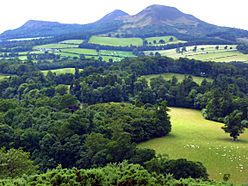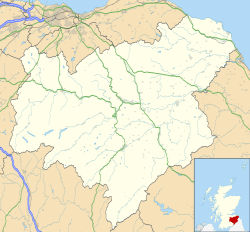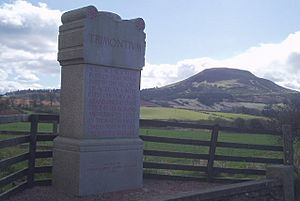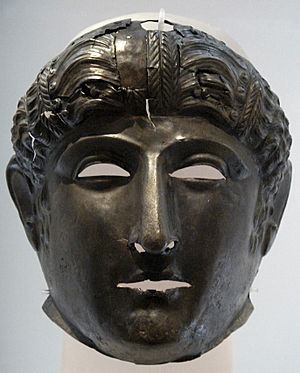Trimontium (Newstead) facts for kids
Quick facts for kids Trimontium |
|
|---|---|

Site of Trimontium with the three peaks
of the Eildon Hills in the background |
|
| Location | |
| Coordinates | 55°36′04″N 2°41′13″W / 55.601°N 2.687°W |
| Town | Melrose |
| County | Scottish Borders |
| Country | Scotland |
| Reference | |
| UK-OSNG reference | NT569344 |
Trimontium was an important Roman fort in Scotland. It was located near Melrose in the Scottish Borders. The name "Trimontium" comes from Latin, meaning "three hills." This refers to the three Eildon Hills that stand nearby.
The fort's location, about 60 miles north of Hadrian's Wall, meant its purpose changed often. Between about 80 AD and 180 AD, the Romans expanded, strengthened, and then retreated from Caledonia (ancient Scotland). These changes greatly affected Trimontium's role and importance.
Contents
The Roman Fort of Trimontium
The Romans quickly conquered southern Britain after their invasion in 43 AD. They then moved north into England and Wales. Their next goal was to push further into southern Scotland.
The Trimontium fort was built on the banks of the River Tweed. The Eildon Hills and an Iron Age hillfort on Eildon North were always visible. These reminded the Romans of the local people and the wild Scottish landscape. The Tweed and Leader rivers helped move goods and people. A Roman road, later called Dere Street, passed right by the fort. This made it a perfect location.
The fort's story reflects the Roman advance and retreat in Scotland. Its role changed from a frontier outpost to a supply base. From its first building around 80 AD to its last use after 180 AD, the fort was a busy place. Both Romans and local people used it. The local Iron Age communities lived in farmsteads. They sometimes gathered in hillforts. They had to find ways to live alongside or deal with the Roman presence. This could mean trading, forming alliances, or even fighting.
Building Phases of the Fort
The fort was built and rebuilt many times. Dr. Simon Clarke of Bradford University has figured out the order of these building and destruction phases. He used findings from early excavations by James Curle (1905–1910) and Sir Ian Richmond (1947). He also used aerial photos and modern digs by Bradford University (1987–1997).
Phase 1: Early Fort (c. 79-87 AD)
- This was the first Roman camp, built around 80 AD by Agricola.
- It had walls made of turf on a stone base.
- Two ditches were dug in front of the walls, overlapping at each entrance.
- An extra area, called an annexe, was on the west side. It had similar turf walls and ditches.
Phase 2: Stronger Fort (c. 90-105 AD)
- The fort might have been empty for a short time.
- Then, the Romans returned and built much stronger defenses.
- Old ditches were filled in, and new ones were dug.
- The new turf wall was very thick (13.5 meters) and tall (about 8.4 meters).
- A single ditch, 5 to 7 meters wide and 2 to 4 meters deep, was in front of the wall.
- New, well-protected annexes appeared on the south, east, and possibly north sides. Civilians and people who followed the army lived here.
Phase 3: Abandoned (c. 105-137 AD)
- Trimontium was left empty. The Roman army moved back south of Hadrian's Wall.
Phase 4: Possible Reoccupation (c. 137-139 AD)
- Dr. Clarke thinks the fort might have been used again a few years before 140 AD.
- This was when Emperor Antoninus Pius planned to advance into Caledonia.
- If so, Trimontium would have been a strong outpost beyond Hadrian's Wall.
- It would have had a civilian population in its annexes.
- Digs show the main entrance was now through the southern annexe.
Phase 5: Supply Center (c. 140-158 AD)
- The Romans pushed further north, and work began on the Antonine Wall (from 142 AD).
- Trimontium's role changed. It became smaller, with a 2-meter thick stone wall built through the main fort.
- Stone was also used for other rebuilding.
- The fort became important for making and supplying goods.
- It was now behind the front lines. It's thought that 2,000 to 3,000 civilians lived near the fort.
Phase 6: Front-Line Fort Again (c. 160 AD)
- The dividing wall built earlier was removed.
- Trimontium became a front-line fort again because the Antonine Wall was abandoned.
- A long, narrow building for soldiers (barracks) was built inside the fort.
- The number of civilians around the fort greatly decreased.
Phase 7: Final Retreat (c. 160-184 AD)
- The civilian population supporting the fort continued to shrink.
- The land where the annexes were started to return to nature.
- The number of soldiers also decreased. The barracks now housed the remaining soldiers and their families.
- The fort was likely left empty around 180 AD.
- It's not clear if the remaining civilians left or stayed.
- Coins from the early 3rd and late 4th centuries have been found nearby. This suggests local people might have continued trading in a Roman way.
Who Lived at Trimontium?
Evidence from the site shows that a large group of cavalry (soldiers on horseback) was at Trimontium. Many items related to horses have been found. These include horse skeletons, parts of horse harnesses, and amazing decorated cavalry helmets and face masks. These helmets can be seen at the National Museum of Scotland in Edinburgh. There's even a possibility of a gyrus, which was a training ring for horses.
The number of people at the fort changed a lot over time. The permanent army group was probably around 1,000 soldiers. But this number would grow with traders, craftspeople, and families linked to the camp. It's estimated that the total number of people could have been anywhere from 2,000 to 5,000.
Discovering Trimontium: Site Archaeology
The first modern mention of Trimontium's importance came in 1846. This was during the building of the Waverley Line railway. Workers found Roman items in pits east of Newstead village.
Early Excavations
James Curle started the first major exploration of the site between 1905 and 1910. He made many important discoveries. These included the foundations of the different forts, which helped explain this unique Roman military site. He also found an amazing collection of Roman armor. This included fancy cavalry parade helmets and horse fittings like bronze saddle plates. Many items related to trade, manufacturing, building, and daily life on the Roman frontier were also found. In 1911, Curle published his findings in a book called 'A Roman Frontier Post and its People'. This book became a key reference for understanding the Roman period in Scotland.
Sir Ian Richmond did smaller digs and re-examined Curle's work in 1947. Around this time, aerial photography became a new tool for archaeology. Dr. J.K. St Joseph used it at Trimontium. He found signs of up to nine temporary Roman camps from crop markings in the fields.
Modern Archaeology: The Newstead Project
In 1989, The Newstead Project began. This was a five-year archaeological study by Bradford University. Dr. Rick Jones and later Dr. Simon Clarke led the project. They used the most modern archaeological methods at Trimontium for the first time.
Towards the end of the project, the Trimontium site faced a challenge. A new bypass road was planned to cut through the fort's south annexe. The Trimontium Trust spoke at two public hearings. They argued that too much historical evidence was in the area to be disturbed. In 1994, Dr. Simon Clarke led a "rescue excavation." He uncovered 40 major archaeological features. These included six deep pits with many organic materials. In 1996, Dr. Clarke returned to study a suspected amphitheater and the north annexe. In 1997, the Bradford University team completed a geophysics survey of the site.
Trimontium in Museums
The Trimontium Trust runs a museum near the Trimontium site in Melrose. As of summer 2020, the museum was being updated. This project, supported by the National Lottery Heritage Fund, aims to improve the displays and tell the story of Trimontium better. The trust also leads guided walks to the site, hosts talks, and offers workshops for schools and families.
Many important items found at Trimontium are displayed at the National Museum of Scotland in Edinburgh. These include the cavalry helmets, decorative face masks, horse chamfrons, and leather items.
The Trimontium Trust's museum project will bring key finds back closer to the original fort site. They will be shown in a modern museum setting. This is part of the trust's plan to expand and redesign how they tell the story of Trimontium and its connection with the local people.





